IT software technology is advancing at a rapid pace, with the internet of things, cloud, automation, and machine learning making networks and network management activities more complex and interdependent. As networks grow and become more complicated, it’s increasingly important for administrators to have access to the tools necessary to conduct essential network monitoring and management operations. One such tool is a network mapper, also known as a network topology mapper.
Unfortunately, choosing the right network mapping tool for your business isn’t easy. The market for network mapping software can leave buyers feeling overwhelmed by the sheer number of options. Do you need an open-source network mapping tool, a free network mapping tool, or a commercial network mapper? Though some of these considerations will be decided by preference, others will come down to the range of each tool’s features, their suitability for business use, and their overall user-friendliness. To help you make the right decision and to save you from spending hours trawling the internet for information, we’ve reviewed the best network topology tools on the market in this guide. To account for a diverse range of needs, we’ve included free network mapping tools, open-source network mapping tools, and commercial network mapping tools.
Overall, SolarWinds® Network Topology Mapper is most highly recommended. This network topology tool is well suited for businesses small and large, as it provides a scalable but user-friendly network mapping solution. Alternatively, SolarWinds Network Performance Monitor helps not just with mapping but also with performance monitoring. Along with understanding your network and visualizing it for you, SolarWinds Network Performance Monitor helps you quickly detect, diagnose, and resolve network performance problems and outages. If you’d like to try these tools, free trials are available.
Logical Network Diagrams vs. Physical Network Diagrams
Why Are Network Maps Important?
Key Network Mapping Software Features
The Best Network Mapping Software
1. SolarWinds Network Topology Mapper (Free Trial)
2. SolarWinds Network Performance Monitor (Free Trial)
3. Paessler PRTG Network Monitor
6. Datadog Network Performance Monitoring
Choosing the Right Network Mapper
You’ll find out how these and other tools stack up throughout this post. But before getting to other network mapping solutions, let’s touch base on some network mapping and topology concepts.
What Is Network Mapping?
Network mapping refers to a process of creating a logical, visual map of a network to help users better understand how the different components connect. Network performance tools often include network mapping utilities because network mapping plays an important role in network optimization. There are also dedicated network mapping and network topology tools.
Network maps can be valuable resources, particularly when administrators are conducting performance monitoring activities. This is because maps can help administrators identify and locate performance bottlenecks, and they give administrators insight into how they can find opportunities for improvement. By leveraging network maps to inform network performance optimization, you can improve service quality for your end users.
Types of network topology
There are six main types of network topologies:
Bus Topology
In a bus topology, every device is connected to a single cable (bus). The data transfer in bus topology happens in a single direction. Bus topology requires less cabling and is less expensive. However, it creates a single point of failure. The bus acts as the backbone for communication between devices, and if the bus is damaged, then it brings the whole network down.
Ring Topology
In a ring topology, every device is connected to two devices, forming a ring-like structure. If two devices need to communicate, they can communicate with each other directly only if they are neighbors. If the devices aren’t neighbors, then these devices have to rely on their neighbors for communication. For example, if device A must communicate with device C, then there are two options:
- A -> B -> C
- A -> E -> D -> C
Star Topology
In this topology, all the devices are connected to a hub. The communication between any devices will have to go through the hub. This type of topology results in high performance, is easy to upgrade, and is commonly used in LANs due to its simplicity.
Tree Topology
This topology follows a hierarchy of devices and consists of root and leaf nodes. In tree topology, lower nodes connect to their root node similar to star topology, and these hubs connect to the main root node like in bus topology. As this is constituted of star and bus topology, it’s also known as star bus topology.
Mesh Topology
Mesh topology follows a simple concept of connecting all devices with every other device. Each device has a dedicated channel with every other device, and devices can communicate with one another directly without having to depend on intermediate nodes.
Hybrid Topology
Each topology discussed above has its own pros and cons. You must choose the best topology for your use case. Hybrid topology combines two or more of the above topologies to create a network that makes use of the pros of each individual topology. The above diagram represents a combination of a star and ring topology.
Speaking of diagrams, there can be two types of network diagrams. Let’s try to understand what they are and how they differ from each other.
Logical network diagrams vs. physical network diagrams
A logical network diagram represents how data flows in the network and how data connections work. It focuses on subnets (including VLAN IDs, masks, and addresses), network devices like routers, firewalls, and routing protocols.
Physical network diagrams, on the other hand, focus on the physical assets that constitute the network. It focuses on cables, workstations, servers, routers, switches, firewalls, etc.
Now that we’ve touched base on some basic network topology concepts, let’s understand why network maps and network map tools are important.
Why are network maps important?
Network maps provide important information and visibility into your organization’s network.. With this information, you can plan maintenance, optimize the network, and set a strategy for upgrades. For example, let’s say you want to upgrade a server that’s crucial for communication for certain devices. If you just take the server offline, it will affect the devices that depend on this server for communication. Network maps can help you predict this situation and plan your task so that it doesn’t affect the operation.
In addition, when there’s an issue within the network, network maps can help you identify where the problem is or what device is causing the problem enabling you to work on fixing the issue faster. This reduces downtime and improvestime to resolution. Network map tools help gain visibility and visualize the network.. If you use a tool that shows live status, it becomes even easier to troubleshoot a problem.
As there are various benefits of network maps and network map tools, it’s important to choose the right tool. But what should a good network mapping system have?
Key network mapping software features
There are several network mapping solutions, and each offers different features. Some of these software solutions address general needs, while others focus on specific aspects of network mapping. Although which tool is best depends on individual requirements, here are some key features a network mapping software should have.
Autodiscovery
Automatic network discovery scans the enterprise to detect network devices and build a schema of the detected devices. It’s a lot of effort for admins to work with a tool that doesn’t have an autodiscovery feature, and it’s inefficient.
Topology Maps
The tool should be able to provide thorough maps of the network. In complex networks, there can be some dependencies and correlations between nodes. The tools should consider all these aspects. Different layouts and degrees of detailing can be useful for different use cases. Dynamic charts, heat maps, and diagramming capabilities are some other features to look for.
Reporting
Visualization is just one way to look at network maps. But you can also use this information as raw data for different purposes. Reports could be visual representations or statistics-focused, and the information to be included in the report could vary depending on the need. A good tool should be able to generate reports as per requirements. It should provide reporting upon request, at scheduled intervals, and be able to export data in multiple formats.
Mapping Wireless Networks
The use of wireless devices has increased over the years. Traditionally, devices were connected using cables. But wireless devices have become an important part of networks in this age. Therefore, it’s important for the network mapping tool to map wireless devices and process information accordingly.
The Best Network Mapping Software
Now that we’ve gone through some of the key features you should look for in a network mapping system, let’s look into some of the best ones available. To help you choose the right network mapping software for your company, here’s our comparison of some of the best network topology tools on the market.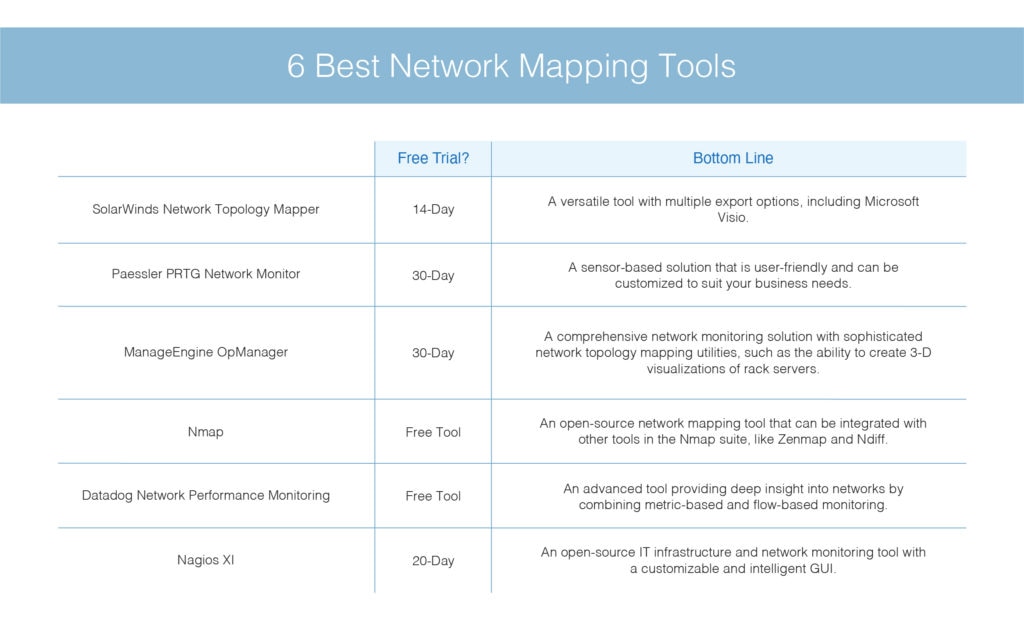
1. SolarWinds Network Topology Mapper (Free Trial)
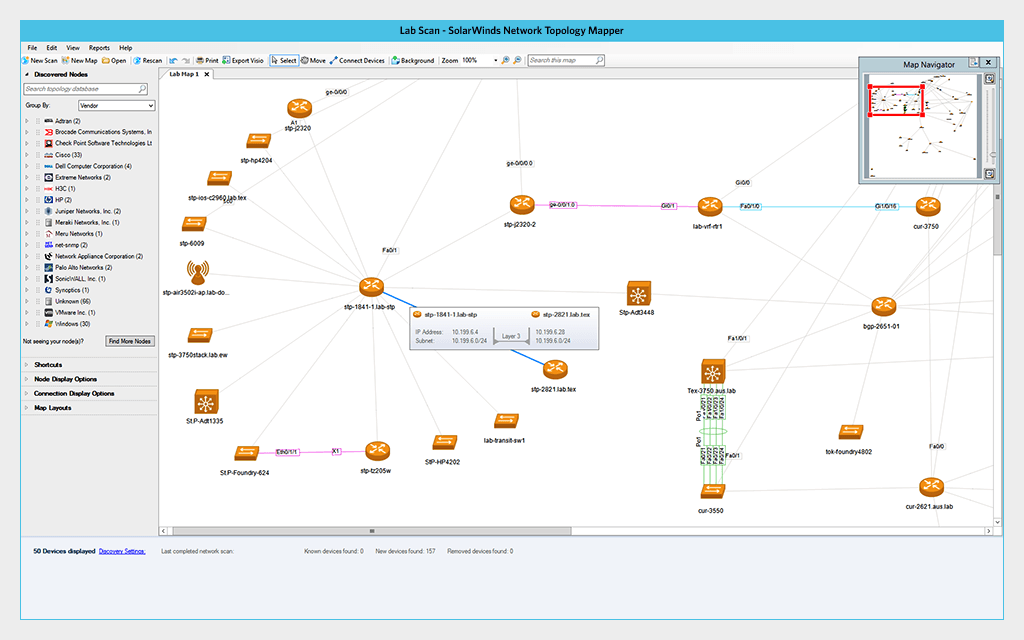
SolarWinds Network Topology Mapper is a highly sophisticated network topology tool offering a wide range of functionalities. This network mapping solution can automatically discover and map your complete network topology, displaying the structure and how each component connects in easy-to-interpret, dynamic diagrams.
Network Topology Mapper combines automation with the ability to perform manual tasks and adjustments, when necessary. For example, you can manually connect devices in the network. You can also customize network node details for map objects. Here are some of the main features of this tool:
- Several discovery method options, including ICMP, CDP, SNMP, Hyper-V, WMI, and VMware
- Multiple export options, with support for exports to PDF, PNG, and Microsoft Office Visio
- Scheduling of updated exports to the Orion® Platform Network Atlas
- The ability to create multiple maps from a single scan
- Automatic detection of changes in network topology and addition of any new devices to existing maps
These are just a few examples of Network Topology Mapper’s comprehensive range of utilities. With its automated capabilities, this user-friendly network mapping tool can free up resources and time so your team can focus on other important operations. You can try Network Topology Mapper free for 14 days.
Download Free Trial Learn More
2. SolarWinds Network Performance Monitor (Free Trial)

SolarWinds Network Performance Monitor’s (NPM) focus is monitoring the performance of the network by making use of network information. Therefore, network mapping is one of its strong suites. NPM scans the network and auto-generates network maps to display the latest information.
NPM provides support for Microsoft Azure with visibility into site-to-site connections, client VPNs, ExpressRoutes for VPN status, and performance metrics. For private cloud visibility, NPM also supports Cisco ACI monitoring and troubleshooting.
Let’s see some of the main features of this tool:
- Multi-vendor network monitoring
- Network insights for deeper visibility
- Intelligent maps
- NetPath and PerfStack for easy troubleshooting
- Smarter scalability for large environments
- Advanced alerting
Along with the above features, NPM also allows you to tune alerts to reduce false positives and receive meaningful alerts. You can try NPM free for 30 days.
Download Free Trial Learn More
3. Paessler PRTG Network Monitor
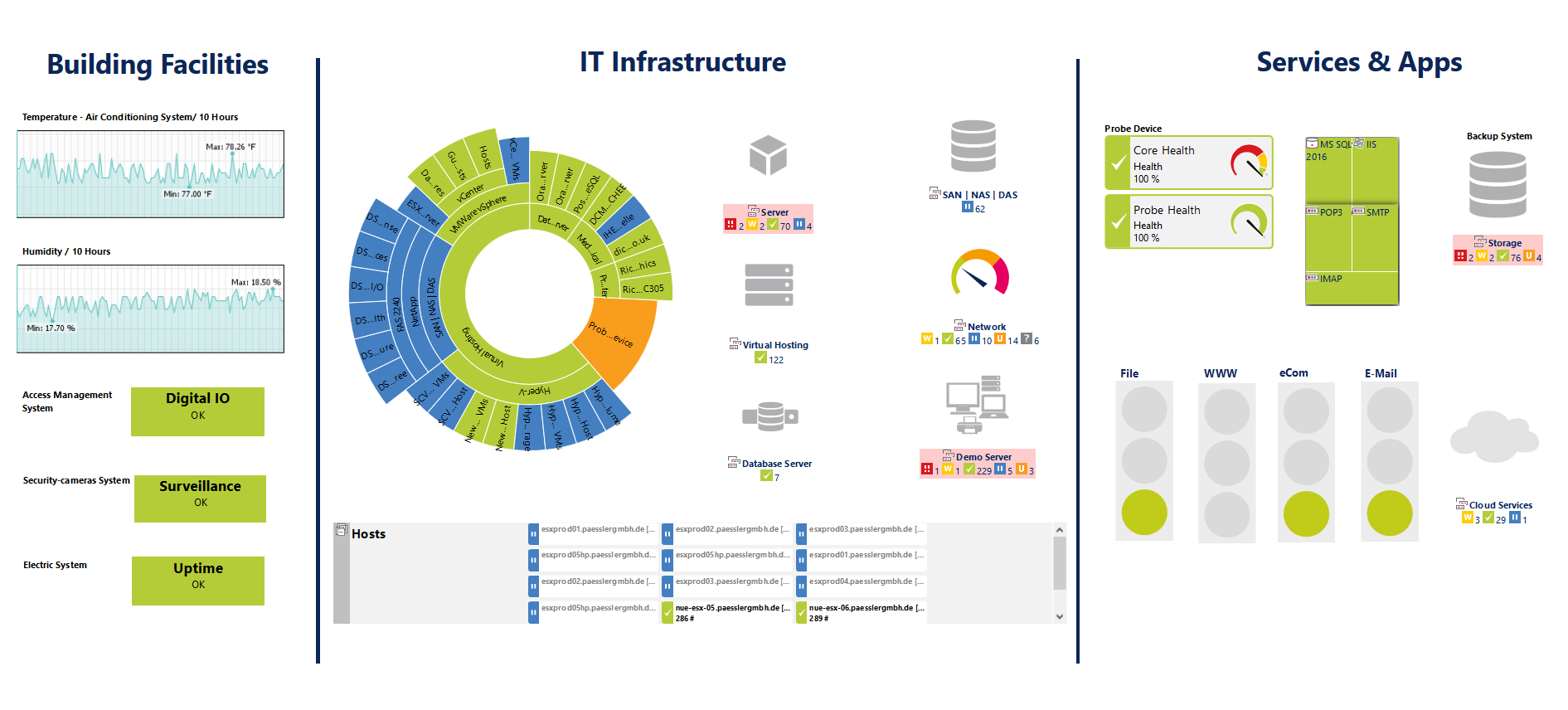
Paessler PRTG Network Monitor is a popular network monitoring and management solution with a unique sensor-based approach to licensing. This tool is what you make of it, which is one of its major benefits. You can implement as many or as few sensors as you require, ensuring you’re never paying for more than you use. Each PRTG sensor monitors a single component, with thousands of sensors to choose from. This enables you to create a solution perfectly tailored to your requirements. PRTG includes numerous sensors for network topology mapping.
Some of the main features of this tool include the following:
- Autodiscovery utility designed to detect all your IT components, including firewalls, routers, switches, applications, servers, virtual servers, and storage systems.
- Integration of components into network topology maps.
- Easy-to-use drag-and-drop map editor.
- Ability to use custom HTML to generate multi-layer maps, allowing you to drill down through the layers quickly and easily to identify and locate errors.
This is an extremely versatile tool offering capabilities far beyond network topology mapping. Because of this, PRTG Network Monitor is best suited for companies hoping to combine network mapping utilities with other monitoring solutions, such as server performance monitoring, virtual environment monitoring, or LAN monitoring.
PRTG Network Monitor includes 100 free sensors, which you can use to build your own network mapping tool. Although there’s an obvious benefit to having a tool with so much flexibility, PRTG Network Monitor can be expensive once you use up your free sensors. A 30-day free trial of PRTG Network Monitor’s unlimited edition is available.
4. ManageEngine OpManager
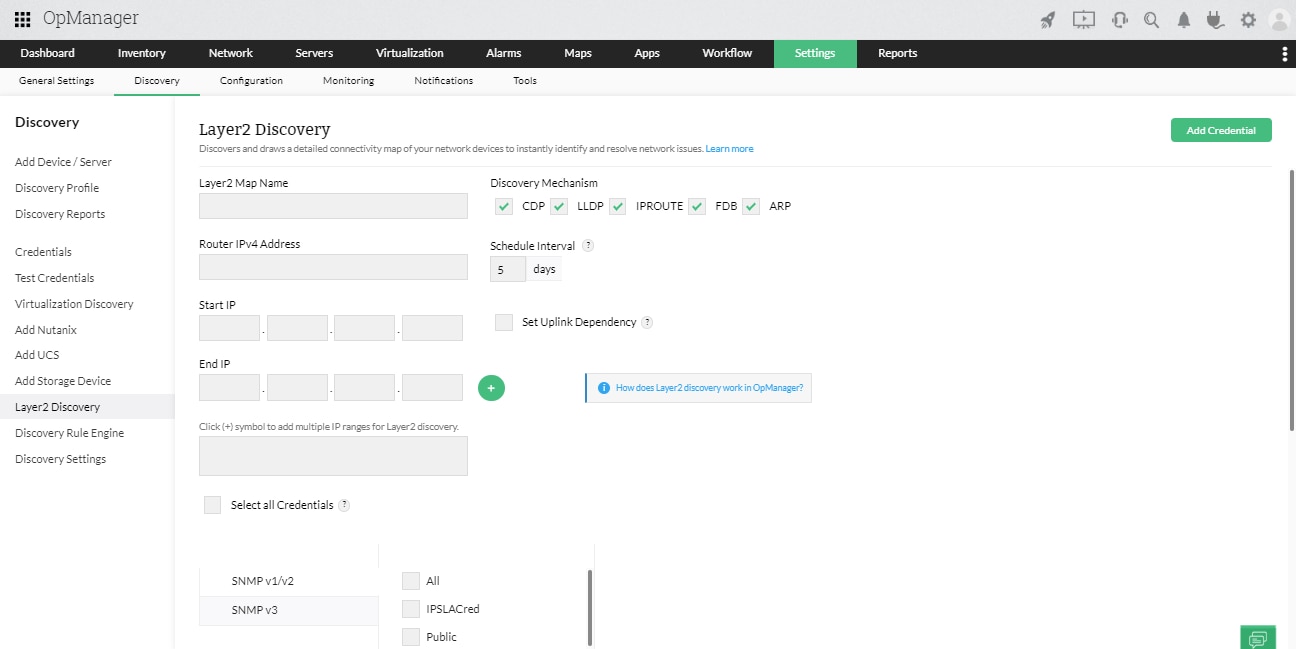
ManageEngine OpManager provides an automated network mapping solution designed to allow you to configure network maps with minimal effort and time. With this tool, you can create 3D visualizations of rack servers, detailed topology maps, and much more.
The network mapping tool included with OpManager is sophisticated and versatile, ensuring your network maps are always up to date by performing periodic network scans. You can export to Microsoft Visio, making it especially easy to share and collaborate on maps.
Some of the main features of this tool are:
- Automatic generation of a complete map of your IT infrastructure that classifies network devices and maps them to a core router.
- Customizable network maps according to your preferred layout and with network seed device details.
- Supports collaboration between team members and departments by allowing you to share network maps and diagrams.
OpManager’s network maps represent the most recent status of your network and use color-coded icons for ease of interpretation. These maps function like a real-time Visio diagram, allowing administrators to identify network issues at a glance and drill down into problematic devices. This tool helps you understand the relationship between parent and dependent devices and enables you to effectively prioritize network issues so you can kick-start remediation quickly.
You can download a 30-day free trial of OpManager.
5. Nmap
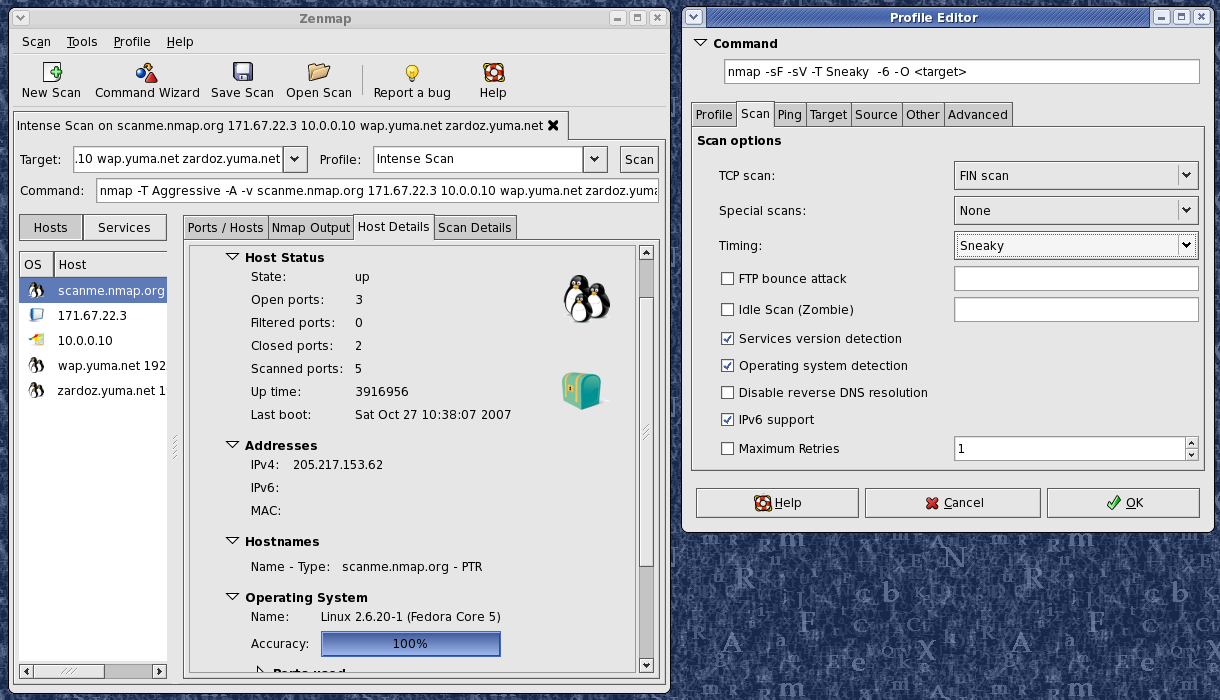
Nmap is a free, open-source network mapping solution popular among users who favor open-source solutions. This solution uses IP packets to determine hosts on a network and the types of services being provided by hosts, and it also uses them to identify firewalls, operating systems, and other useful information.
Main features of this tool:
- Service and OS detection
- Port rules discovery
- Different types of scanning
You can run Nmap on Linux, Windows, and macOS X and link it with other tools in the Nmap suite, including Ncat, Nping, Ndiff, and Zenmap. Getting used to Nmap can be challenging, as it comes with an initial learning curve, but once you’re familiar with the tool, it can be useful. As a free tool, it’s unlikely to be scalable enough for business use. You can download Nmap here.
6. Datadog Network Performance Monitoring

Datadog, a big name in IT infrastructure monitoring and management, provides a network performance monitoring tool with a tag-based approach to network mapping. This tool can monitor performance for both cloud-based and on-premises networks, and it offers an impressive range of network monitoring utilities.
With Datadog Network Performance Monitoring, you can gain full visibility into your network’s traffic as well as infrastructure metrics, logs, and traces. By combining metrics-based and flow-based monitoring, this tool gives you deep insight into your network environment. With this solution, network topology maps are interactive, which allows you to engage directly with the data and assists with rapid identification of traffic bottlenecks.
Some of the main features of this tool are:
- Performance monitoring for both cloud-based and on-premises networks
- the ability to map network traffic flow between containers, hosts, availability zones, teams, services, etc.
- Centralized and user-friendly console
- Metrics-based and flow-based monitoring
As a solution you can use with hybrid and cloud-based networks, Datadog Network Performance Monitoring has some notable advantages. It’s easy to use and navigate, although some users have reported that the console feels cluttered. You can sign up for a 14-day free trial of Datadog.
7. Nagios XI
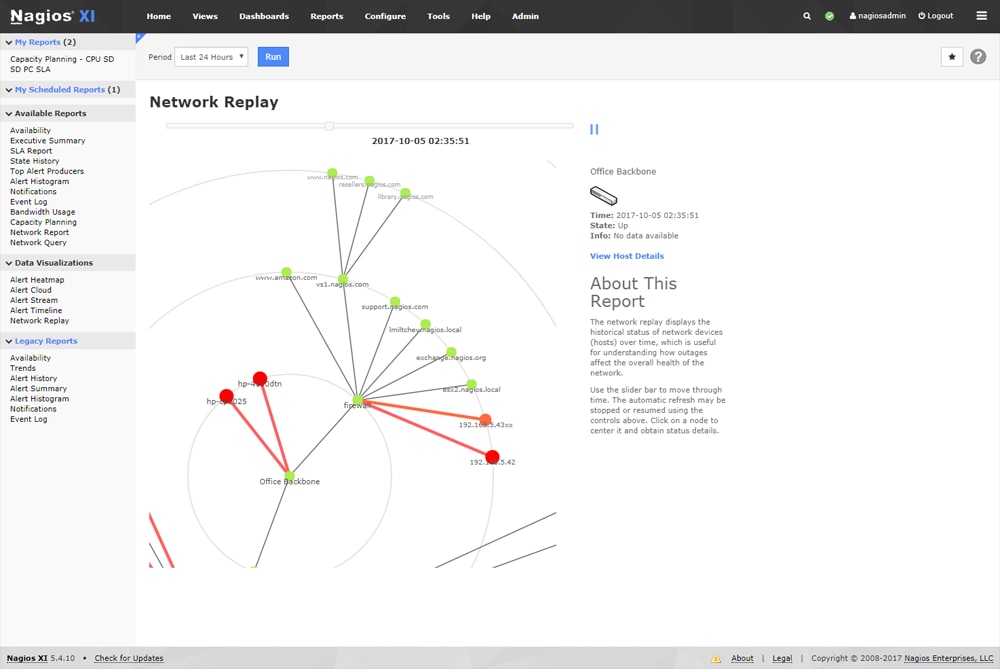
Nagios XI is another open-source network mapping tool t’at’s well known as a powerful and dependable solution. Nagios XI can provide comprehensive and efficient network and IT infrastructure monitoring, offering a centralized view of your network and everything happening within it.
Some of the main features of this tool are:
- A customizable dashboard where you can view network devices, hosts, and services
- Automated network discovery
- Support for bulk host imports
- The ability to save configurations
With Nagios XI’s intelligent user interface, you can customize the program’s design and layout as well as your user preferences. This secure solution makes setting up and managing user accounts easy. Although it’s well suited to users who prefer the flexibility of open-source solutions, Nagios XI is unlikely to be appropriate for enterprise environments. You can download Nagios XI here.
Choosing the Right Network Mapper
As this guide has demonstrated, there are plenty of options available on the market for businesses and IT professionals looking for a network topology mapping tool. Overall, the most versatile and reliable of these products are SolarWinds Network Performance Monitor and Network Topology Mapper. These tools offer a specialized and comprehensive approach to network mapping, giving you access to all the capabilities necessary to support and streamline your network monitoring and management activities.





